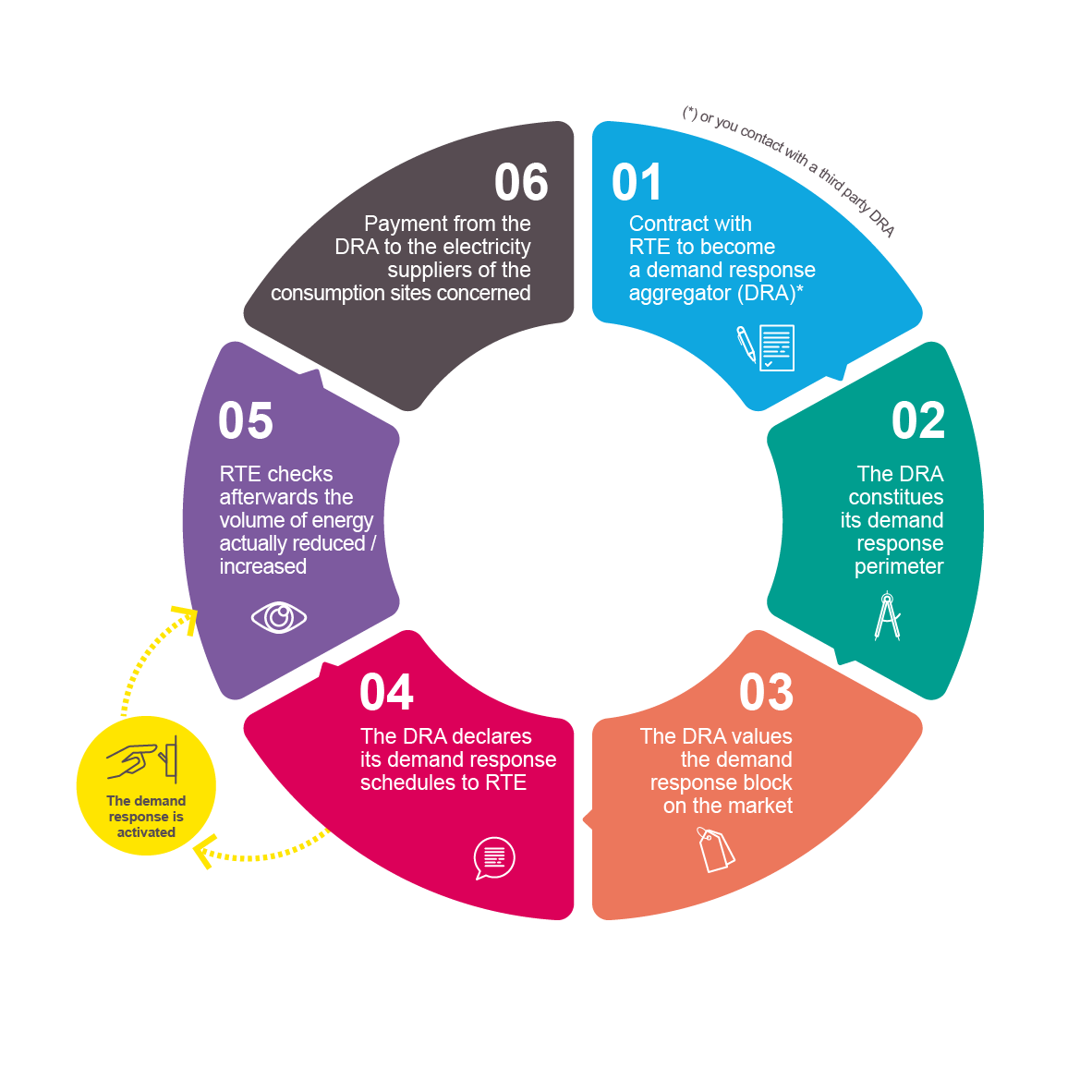Do you have an account?
Why create an account?
After creating an account you will :
- have access to the “favourites” feature,
- be able to download certain data published by RTE,
- have access to forms (PKI certificate, EIC code, Customer questionnaire - KYC),
- have access to notifications.
If you are an RTE customer, feel free to contact your administrator so that he or she can give you access to your company’s services.
The NEBCO mechanism makes it possible to value consumption reductions on the electricity market and, in certain cases, the related anticipated or postponed consumptions. It just provides to consumption reductions an additional economic area to the balancing mechanism..
Participating
All consumption sites connected in mainland France may participate in the NEBCO mechanism by providing consumption reduction in exchange for remuneration on energy markets (either over-the-counter or via day-ahead and intraday power exchanges), on fair and equal terms with generation and this without the agreement of suppliers being required.
For four control methods of the achieved consumption, this mechanism also allows for the consideration and valuation of anticipated and posponed consumptions linked to consumption reductions in the context of consumption shifts.
The term demand response includes consumption reduction or a temporary increase in consumption before or after a period of reduction in the context of a consumption shift. In the case of a one-off decrease in consumption, the demand response is called “downward variation” or “consumption reduction” or « load reduction ». In the case of a one-off increase in consumption, the demand response is called “upward variation.”
Possible type of demand response depending on control method for the achieved consumption
|
Method |
Possible type of demand response |
|
Corrected double reference rectangle |
|
|
Consumption forecast |
|
| Consumption history |
|
|
Site-to-site algebraic rectangle |
|
|
Panels |
|
Upward variations must be realised in the context of a shift in consumption. As a result, they must be proportionate and linked in time to downward variations. Two indicators can be used to verify this consistency:
• the energy balance, which aims to verify that the volumes of upward variations do not exceed the volumes of downward variations
• the energy ratio, which aims to monitor changes in the proportion of upward consumption variations relative to downward consumption variations
These two indicators are calculated on a calendar month basis..
You may participate:
-
either directly by becoming a demand response aggregator (DRA), if the site has a minimum load reduction capacity of 100 kW,
-
or indirectly, calling on a third party DR aggregator. The consumer is then paid (downward variation) / billed (upward variation) according to the terms of the contract with the demand response aggregator.
From contracting to remuneration

The DRA may combine several sites within its perimeter. The attachment of a consumption site to a demand response perimeter is conditional on the agreement of the site. The DRA sells the load reduction (downward variation) / buys the energy (upward variation) on the energy market and declares its downward/upward variation schedules to RTE, from 9am the day before, until 1 hour before the start of the consumption variation on day D. Loads reductions in energy markets are remunerated by means of payment from the DRA to the electricity suppliers of the consumption sites concerned. RTE provides the fixed scale applied for the regulated model (see chapter «Complementary services» below).
Until date NF35, upward variations are not permitted during the PP1 periods specified in the Capacity Mechanism in force on 1 September 2025 or during periods of tension in the Capacity Mechanism in force.
Contracting
To become Demand Response Aggregator, you must:
- sign a participation agreement to the market rules “NEBCO” (see chapter “ Reference documentation” below)
- obtain a technical approval that certifies your ability to manage consumption variations, based on a file and tests.
- have a balance perimeter (by being Balance Responsible Party - BRP - or with a third party BRP).
Report accompanying NEBCO rules
Where appropriate :
- RTE verifies the actual load reduction and when appropriate the actual upward consumption variation of your entity based on the method you have selected. There are several load reduction check methods: to benefit from load reduction checks based on forecast and based on historical data, the site must apply for certification.
- If you wish to participate in the submetering experiment, you and the relevant remotely-read consumption sites need to obtain a qualification from RTE.
- So as to request a qualification for small scale consumption, RTE will order relevant audits to the inspection authority at the expense of the aggregator. The aggregator will be contacted directly by the inspection authority to organise the site visits.
Access the information system
To participate as demand response aggregator, you must have access to RTE’s information system and exchange data exchange as per the arrangements described in the NEBEF IS rules.
- RTE IS access form
- NEBEF IS Terms and Conditions applicable as of 1st april 2025
- User manual of the NEBEF 1 API (transmission and consultation of NEBEF load response data)
- Implementation guide for DSO exchanges - DRA
Complementary services
For more transparency, RTE provides you with a set of data services :
- Aggregated NEBEF load reduction volumes and achieved load-reduction logs within the perimeter of France
- List of Demand Response Aggregators
- Fixed scales (regulated model)
- Test protocols
- Reliability indicators of load reductions at activation
- Load reductions: Certification quality criteria for forecast and history methods
Reference documentation
Find out more
Be remunerated for your generation and consumption flexibilities
Contact
Your sales representative or marketservices@rte-france.com is at your disposal for any additional information.
